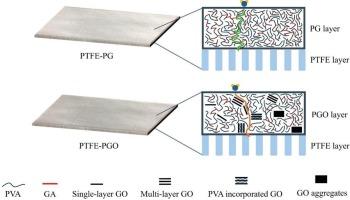膜蒸馏用可扩展聚合物基涂层异质结构复合膜的研制
IF 9.8
1区 工程技术
Q1 ENGINEERING, CHEMICAL
引用次数: 0
摘要
膜蒸馏(MD)有望用于高盐度废水处理,但其工业部署受到膜润湿,污染和温度极化的阻碍。传统的MD膜缺乏化学通用性和结构设计,需要同时克服这些限制。为了解决这些差距,在微孔聚四氟乙烯(PTFE)载体上开发了由聚乙烯醇(PVA)/氧化石墨烯(GO)杂化层组成的可扩展双层膜,旨在增强抗湿/污垢性能并保持稳定的分离性能。由于氧化石墨烯和聚乙烯醇之间的界面相容性,PVA基层表现出可调节的物理化学性质。双层膜的热导率呈非均匀性,具有温度极化减轻的特点。当应用于直接接触MD工艺时,与原始PTFE膜相比,双层膜表现出明显增强的稳定性。使用含有0.4 mM十二烷基硫酸钠和3.5 wt% NaCl的水相混合料,与原始PTFE相比,氧化石墨烯负载为3 wt%的复合膜的水蒸气通量增加了25%,同时在50°C(渗透温度为10°C)下保持99.9%的盐去除率。此外,通过实际的垃圾渗滤液处理,进一步验证了膜稳定性的提高,在50小时的长期耐久性测试中,3wt %氧化石墨烯复合膜始终保持高质量的渗透。这些结果证明了设计具有更高稳定性和热效率的可扩展MD膜的策略,提高了它们在工业应用中的潜力。本文章由计算机程序翻译,如有差异,请以英文原文为准。

Development of heterostructure composite membranes with scalable polymer-based coating layers for enhanced membrane distillation
Membrane distillation (MD) holds promise for high-salinity wastewater treatment, but its industrial deployment is hindered by membrane wetting, fouling and temperature polarisation. Conventional MD membranes lack the chemical versatility and structural design needed to simultaneously overcome these limitations. To address these gaps, a scalable dual-layer membrane consisting of a poly (vinyl alcohol) (PVA)/graphene oxide (GO) hybrid layer on a microporous polytetrafluoroethylene (PTFE) support was developed, aiming to enhance wetting/fouling resistance and maintain stable separation performance. The PVA based layer was manipulated to exhibit tuneable physicochemical properties due to the interfacial compatibility between GO and PVA. The thermal conductivities of the dual-layer membranes were heterogeneous, featuring alleviated temperature polarisation. When applied in the direct contact MD process, the dual-layer membranes exhibited noticeably enhanced stability in comparison with the pristine PTFE membrane. Using an aqueous feed mixture containing 0.4 mM sodium dodecyl sulfate and 3.5 wt% NaCl, the composite membrane with 3 wt% GO loading achieved a 25 % increase in water vapor flux compared to pristine PTFE, while maintaining 99.9 % salt rejection at 50 °C (with a permeate temperature of 10 °C). Furthermore, the improved membrane stability was further validated by real landfill leachate treatment, where the 3 wt% GO composite membrane consistently yielded high-quality permeate throughout a 50-h long-term durability test. These results demonstrate a strategy for designing scalable MD membranes with improved stability and thermal efficiency, advancing their potential for industrial applications.
求助全文
通过发布文献求助,成功后即可免费获取论文全文。
去求助
来源期刊

Desalination
工程技术-工程:化工
CiteScore
14.60
自引率
20.20%
发文量
619
审稿时长
41 days
期刊介绍:
Desalination is a scholarly journal that focuses on the field of desalination materials, processes, and associated technologies. It encompasses a wide range of disciplines and aims to publish exceptional papers in this area.
The journal invites submissions that explicitly revolve around water desalting and its applications to various sources such as seawater, groundwater, and wastewater. It particularly encourages research on diverse desalination methods including thermal, membrane, sorption, and hybrid processes.
By providing a platform for innovative studies, Desalination aims to advance the understanding and development of desalination technologies, promoting sustainable solutions for water scarcity challenges.
 求助内容:
求助内容: 应助结果提醒方式:
应助结果提醒方式:


